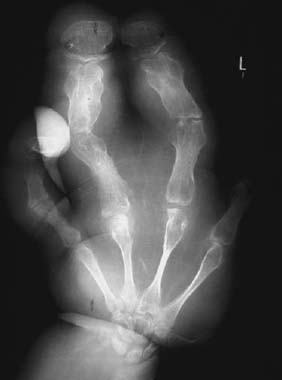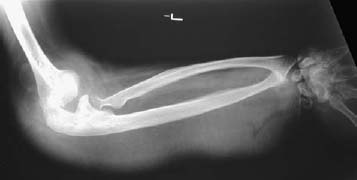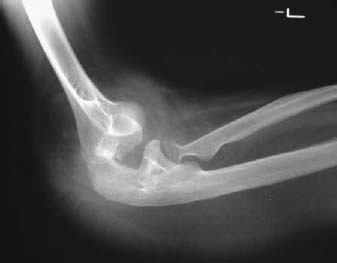CASE 38 Anthony G. Ryan and Peter L. Munk A patient presented with the left hand larger than the right since birth, with associated gross forearm soft-tissue swelling. Figure 38A Figure 38B Figure 38C An anteroposterior radiograph of the left hand (Fig. 38A) shows markedly abnormal second and third digits, with an absent fifth digit. The phalanges of the involved digits are massively enlarged in both longitudinal and axial planes, with “splaying” most marked distally. Clinodactyly of the affected digits is present. There is a pathological fracture of the proximal phalanx of the third digit with resultant deformity. Endosteal bone resorption and subsequent remodeling are evident, most marked in the middle phalanx of the third digit. The forearm radiograph (Fig. 38B) and corresponding focused view of the elbow (Fig. 38C) show massive soft-tissue swelling with prominent lucent foci, highly suggestive of macroscopic fat within the lesion. Macrodystrophia lipomatosa (nerve territory-oriented macrodactyly). The condition is congenital but not hereditary; however, the precise etiology of macrodystrophia is unknown. A related condition involves the presence of a fibrolipomatous hamartoma of a nerve that gives rise to an indistinguishable clinical pattern. The neural fibrolipoma causes local gigantism in the affected nerve’s territory, resulting in progressive overgrowth of all mesenchymal elements, particularly fibroadipose tissue. The condition may be associated with other local developmental abnormalities, such as polydactyly. Males and females are equally affected.
Macrodystrophia Lipomatosa
Clinical Presentation



Radiologic Findings
Diagnosis
Differential Diagnosis
Discussion
Etiology
Pathophysiology
Clinical Findings
Stay updated, free articles. Join our Telegram channel

Full access? Get Clinical Tree


